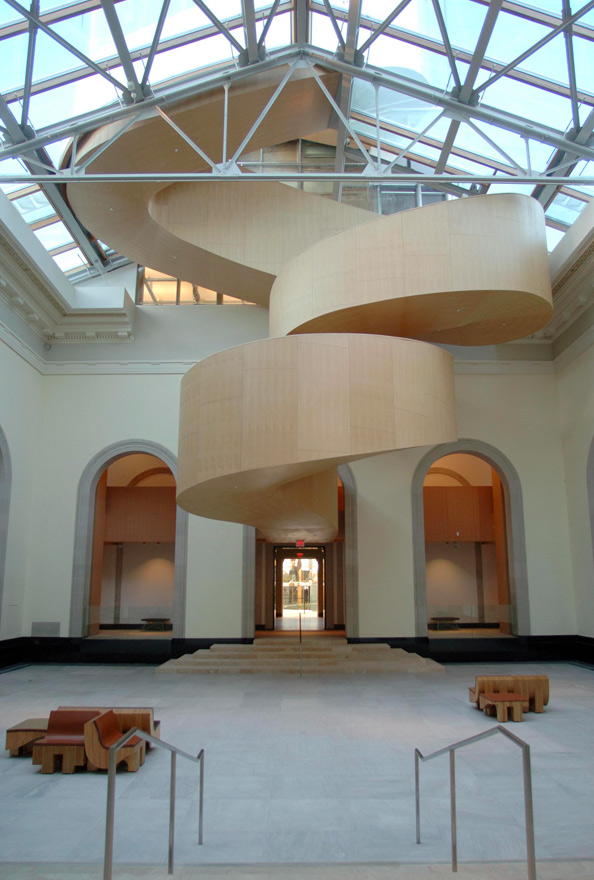 Around this time last year, I took a day trip
with some gallery colleagues to Toronto for a whirlwind tour of the galleries
and museums there. Now, I’m longing to go back, and the top attraction on my
list is the Art Gallery of Ontario (AGO), which is actually an art museum with
artworks as old as 100 A.D. I love visiting museums because there is an
exclusive nature to historical art. You will almost never see an artist’s full
collection at a single museum, so you have to travel to see the works of a
favorite artist. Any art history nerd will agree that there is an amazing
difference between seeing an image of an artwork and seeing it in person (which
is probably why I tear up almost every time I am faced with the enormous scale
of a tapestry.)
Around this time last year, I took a day trip
with some gallery colleagues to Toronto for a whirlwind tour of the galleries
and museums there. Now, I’m longing to go back, and the top attraction on my
list is the Art Gallery of Ontario (AGO), which is actually an art museum with
artworks as old as 100 A.D. I love visiting museums because there is an
exclusive nature to historical art. You will almost never see an artist’s full
collection at a single museum, so you have to travel to see the works of a
favorite artist. Any art history nerd will agree that there is an amazing
difference between seeing an image of an artwork and seeing it in person (which
is probably why I tear up almost every time I am faced with the enormous scale
of a tapestry.)
The AGO’s European collection holds master
artists including Anthony van Dyck, Auguste Rodin, Peter Paul Rubens, Edgar
Degas, and Claude Monet. Since I was on a research trip for a contemporary
gallery, my rushed visit did not include much of the historical collections.
But, what I did see stopped me dead in my tracks.
A walk up the newly added Baroque staircase
leads you to the centre for contemporary art – and that’s where I first saw the
work of David Altmejd, Canadian-born sculptor and installation artist. I was immediately
captured by his installation, The Index,
and I spent the majority of my time allotment exploring the mirrored caverns
and gawking at the crystallized taxidermy of his imagination. Of course, pictures will never do justice to the way this installation made my heart skip a beat and my breath catch in my throat.
According to my
blurry cellphone picture, the gallery label reads:
Human, animal and plant forms collide and intersect in this complex installation. Stuffed birds, squirrels, and werewolves in mirrored crates are [unreadable] alongside quartz, glitter, mushrooms, pine needles, moss, flowering plants and bird-like figures in suits. The title of the work, The Index, suggests collecting and diversity, though Altmejd deviates from the neat and orderly structure we usually associate with indexes. Here he considers the relationship among all living things, exploring issues such as identity, sexuality, community, and the cloning and mutation of species. Architecture and mirrors draw us into the maze-like work, inviting us to create our own narrative and implicating us in the biodiverse hybrid world and the natural cycle of life and death.
Human, animal and plant forms collide and intersect in this complex installation. Stuffed birds, squirrels, and werewolves in mirrored crates are [unreadable] alongside quartz, glitter, mushrooms, pine needles, moss, flowering plants and bird-like figures in suits. The title of the work, The Index, suggests collecting and diversity, though Altmejd deviates from the neat and orderly structure we usually associate with indexes. Here he considers the relationship among all living things, exploring issues such as identity, sexuality, community, and the cloning and mutation of species. Architecture and mirrors draw us into the maze-like work, inviting us to create our own narrative and implicating us in the biodiverse hybrid world and the natural cycle of life and death.
Altmejd has quickly made a name for himself
in the contemporary art world. He received a BFA from the Université du Québec
à Montréal in 1998 and an MFA from Columbia University in 2001. The Index was a pivotal work for Altmejd.
The installation was first exhibited in 2007 at the Venice Biennale – making him
the youngest artist to represent Canada in this prestigious exhibit. The work
was then promptly purchased by AGO. There are already published monographs
monographs on
this young artist – including a book
on
this young artist – including a book completely dedicated to The Index. You can also read more about
David Altmejd here, here, and here.
completely dedicated to The Index. You can also read more about
David Altmejd here, here, and here.
If I hope to see The Index again soon, I’ll have to return to AGO before October, which I
fully intend to do. For that visit I will be able to go at my own pace and
promise to report back to you on the historical art collections of this museum.




.png?format=500w)

_003.jpg?format=500w)
No comments:
Post a Comment